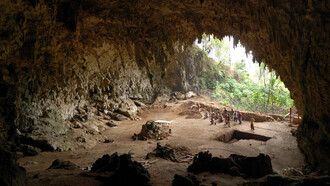The kingdom of Morocco is a land of addition of civilizations and cultures and ancestral history, has never ceased to satisfy human curiosity about human origins. Thus, several Paleolithic discoveries have been identified, in particular the first human activity at Carrière Thomas (Casablanca), 1.3 million years old, Homo sapiens at Jebel Irhoud (Youssoufia / 300,000 years), the first symbolic innovation in the world in Bizmoune (Essaouira), and the oldest Homo sapiens DNA in Africa at the Grotte des Pigeons (Taforalt / 15,000 years).
The kingdom of Morocco hosts the remains of the oldest Homo Sapiens dating back 300,000 years, which were discovered in Jbel Irhoud, a former Baryte mine located near El Youssoufia, in west-central Morocco.
The fossils of the Homo Sapiens are currently stored at the National Institute of Archeology and Heritage in Rabat.
A 150,000-year-old jewelry set discovered in Essaouira
The oldest jewel in the world has just been discovered in Essaouira. This discovery has opened new horizons for humanity on earth. It consists of 32 shells fashioned from marine gastropods in a level dating from 142,000 to 150,000 years ago and which are artifacts made from the shells of Tritia gibbosula.
Perforated voluntarily by man to be worn as necklaces, bracelets and even attached to clothing, these seashells wore a red color which may have as meaning blood, life or family ties. This type of prehistoric adornment appears more abundantly in Morocco than elsewhere in the few countries of Africa and the Middle East.
Bizmoune's discovery also offers crucial information on the origin of symbolic human behavior, which can have several meanings, namely clues on the relationships and relationships between members of the same group or other communities, or on the presence of a common language and identity.
These shells discovered cannot be eaten in view of their size, which is less than 4 cm and also highlights the place of women who would have an important role in the societies of Homo sapiens 150,000 years ago, from by the general shape of the artifacts reminiscent of that of a woman.
The discovery of Bizmoune was carried by a multidisciplinary and international team of researchers, led by the professor of prehistoric archeology at the National Institute of Archaeology and Heritage Sciences (INSAP), Abdeljalil Bouzouggar.
The oldest human clothes were made in Morocco 120,000 years ago
A new major discovery has just been made in Morocco and allows us to better understand the habits and customs of the Neanderthals. The discovery of tools for processing leather and skins was done by American researcher Emily Hallett from the Arizona State University in the smugglers cave about seventeen kilometers from Rabat-Casablanca coastal road.
The discovered tools are made from bones that are 120.000 years old, the researchers identified a total of 12.000 bone fragments, sixteen of which are mostly bovine ribs, and they were formed by humans to be used as tools.
Morocco hosts unknown species of Rhinoceros
Digging research done by fossil hunters in a region near Ouarzazate, Southern of Morocco, led to the discovery of unknown species of rhino that lived in Morocco in ancient times.
The species has been named Eozara xerrii and it is the unique archetypal of the subfamily of Elasmotheriinae in Northern Africa.
Denis Geraads of the Paleontology research center of Paris and Samir Zouhri from the Geology department at the Faculty of Aïn Chock in Casablanca said that it is a complete skull with articulated mandible remains plus some fragmentary remains. According to the two researchers, it is the most well-known Elasmotheriinae of the Late African Miocene.
Oldest Acheulean discovery near Casablanca
An international team has discovered North Africa's oldest Acheulean, dating back 1.3 million years, on the outskirts of Casablanca in Morocco.
According to the famous Moroccan archaeologist Abdelouahed Ben Nacer this new chronological rebound the kingdom position on the scale of the African continent, where the Acheulean is dated back to about 1.85 million years in East Africa and about 1.6 million years in South Africa.
In a press conference to present the discovery Mr. Abderrahim Mouhib, the co-director of the Franco-Moroccan “prehistory of Casablanca” program, the discovery will have an impact on the debate about the emergence of the Acheulean in Africa.
The old medina of Salé hosts important archaeological remains
Important remains and archaeological structures were found during the rehabilitation work of an ancient hotel "Foundouk Al Kaa Al Kadima" at the center of the city of Salé. The discovery was made during the execution of the project launched by his majesty the king to enhance the old medina, said the department of culture of the Ministry of Youth and culture and communication.
Following initial expertise carried out by the competent services of the regional directorate of culture of Rabat-Salé-Kénitra and the Ministry of youth, culture and communication, it was agreed between the various stakeholders to carry out an excavation on the site to know the nature of the discovery and to understand more about the historical stages that belong to.
These excavations continue by a team of archaeologists under the supervision of the head of the Islamic archeology department at INSAP, Dr. Lahcen Taouchikht, until the first week of July. According to the statement, the excavations have so far allowed the discovery of archaeological structures identifying the major stages of use of the site throughout its history.















